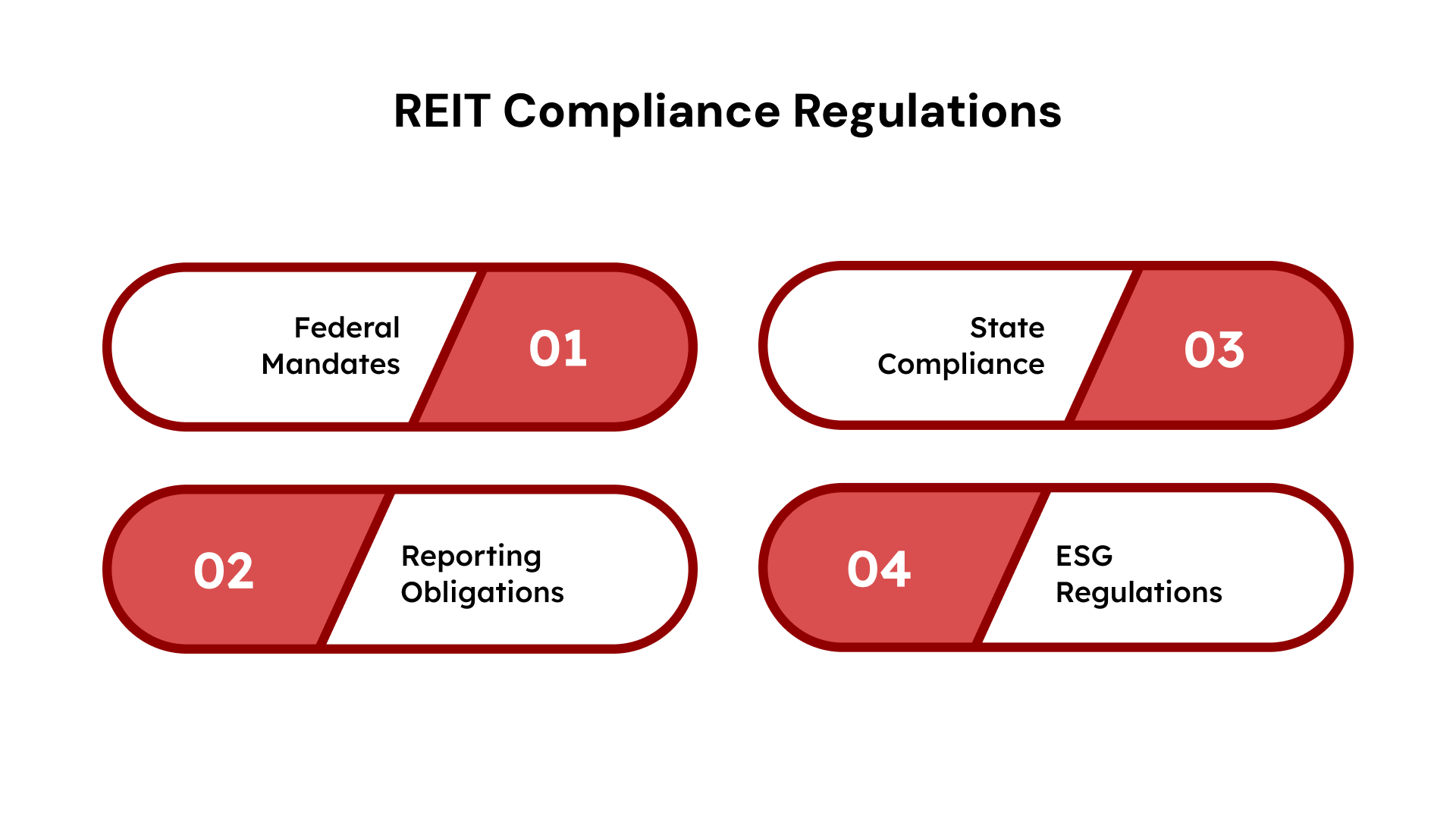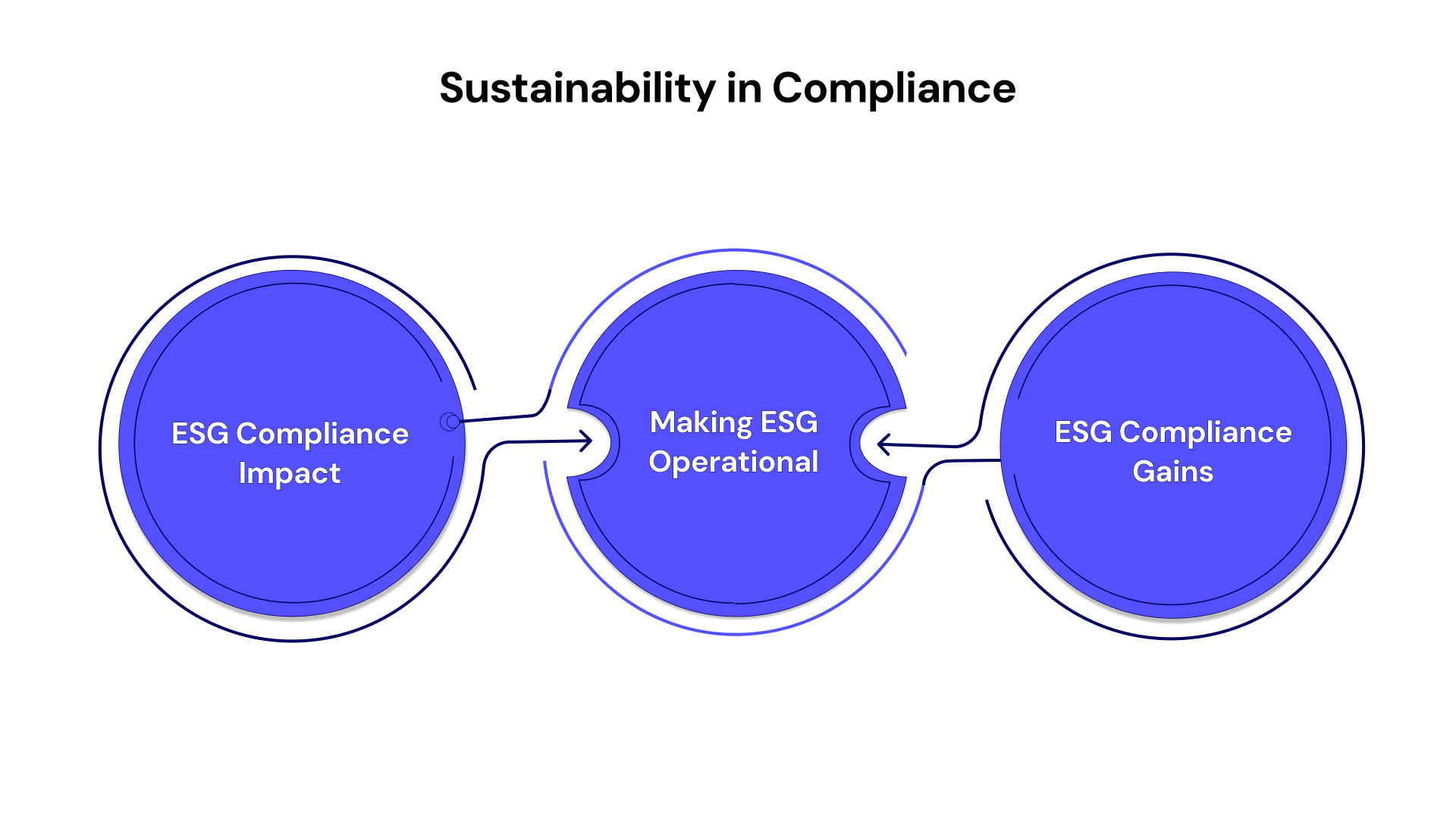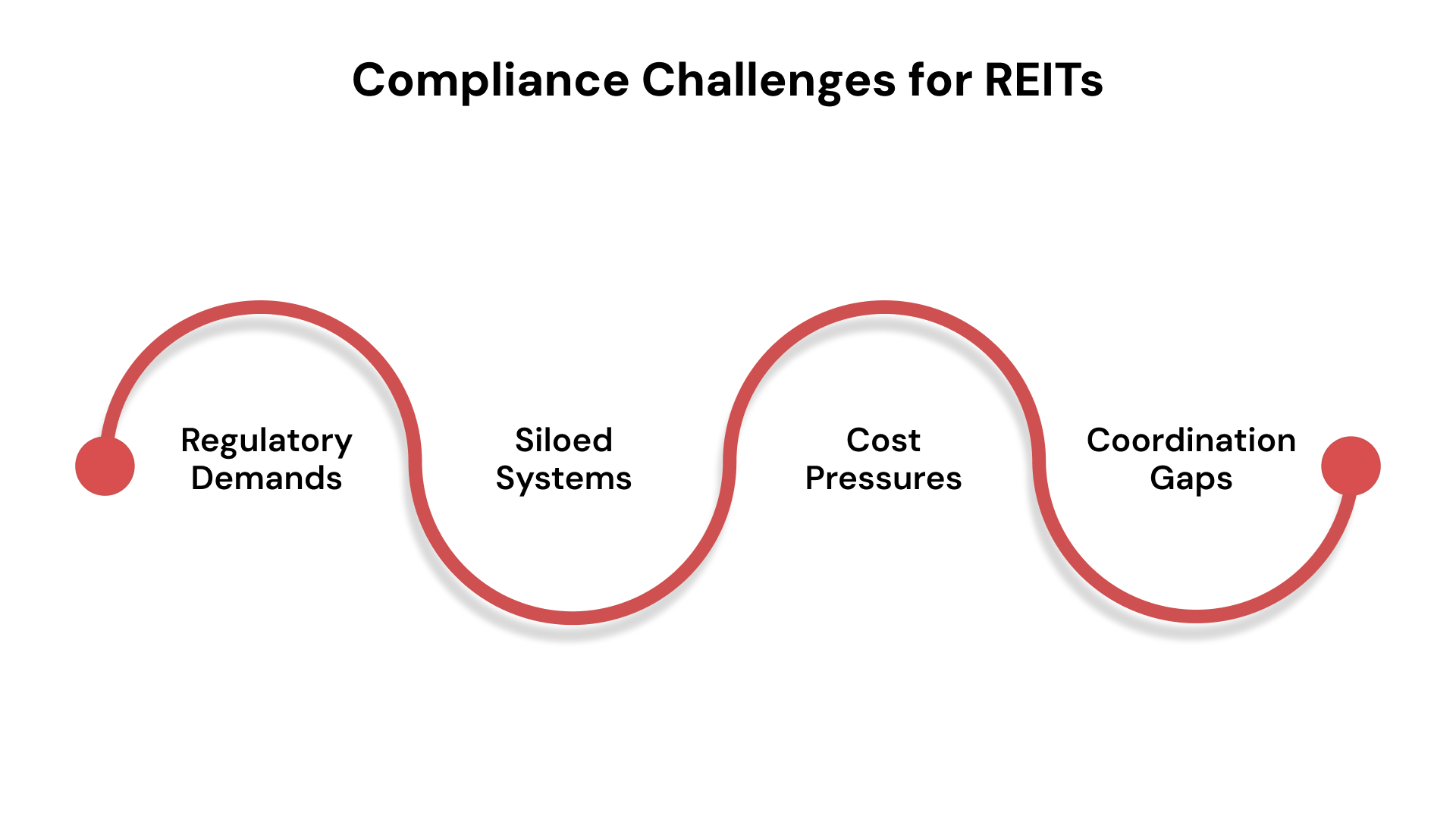REIT Compliance Requirements and Strategies for 2025
REIT compliance involves meeting a range of financial, regulatory, and operational standards necessary to maintain their legal and tax status. Unlike regular corporations, REITs operate within a unique regulatory environment, adhering to strict federal tax rules, SEC filing requirements, shareholder disclosures, and governance standards while also addressing state-level regulations and growing ESG expectations. Compliance for REITs is built around four key pillars: tax qualification, financial reporting, governance and controls, and transparency and disclosure. Each pillar requires accurate documentation, careful coordination, and scalable processes—something that manual methods can struggle to achieve.

Compliance has become a defining factor in the success or failure of real estate investment trusts (REITs). As regulatory demands grow more intricate, the cost of missteps is no longer just financial, it’s reputational.
To maintain their tax-advantaged status, REITs must comply with strict IRS rules, including distributing at least 90% of taxable income to shareholders. This involves navigating complex adjustments for non-cash deductions and certain post-foreclosure gains. With growing IRS scrutiny and rising investor expectations, the margin for error is shrinking.
At the same time, evolving ESG disclosure mandates, intensified SEC oversight, and stricter internal controls are pushing REIT compliance teams to do more without draining resources or stalling growth.
In this high-stakes environment, compliance has become a strategic pillar that strengthens governance, builds investor confidence, and safeguards long-term performance.
This article breaks down what REIT compliance entails and why meeting these obligations now requires a smarter, tech-enabled approach.
Key Takeaways
- REIT compliance spans IRS qualifications, SEC reporting, shareholder disclosures, ESG mandates, and cybersecurity, requiring coordination across multiple functions.
- Missing a single filing or disclosure can lead to financial penalties, loss of tax status, and reputational damage. Consistent execution is critical.
- Manual processes and siloed systems make it difficult to manage growing compliance obligations at scale, especially with overlapping state and federal requirements.
- Building structured workflows, assigning clear ownership, and using real-time dashboards are essential for staying audit ready and reducing risk.
- Strong compliance operations support investor trust, lower costs, and long term growth when supported by scalable systems and automation.
What is REIT Compliance?
REIT compliance refers to the structured adherence to financial, regulatory, and operational standards that real estate investment trusts must meet to maintain their legal and tax status. It’s foundational to how REITs operate, report, and earn investor trust.
Unlike typical corporate entities, REITs face a unique regulatory landscape. They must align with strict federal tax rules, file with the SEC, manage shareholder disclosures, and maintain governance standards, all while navigating state-level requirements and rising ESG expectations.
At a high level, REIT compliance focuses on four critical pillars:
- Tax Qualification: Ensuring compliance with IRS rules around income composition, distribution, and entity structure.
- Financial Reporting: Meeting SEC filing standards and issuing accurate shareholder reports.
- Governance and Controls: Managing internal oversight, policy frameworks, and executive-level disclosures.
- Transparency and Disclosure: Delivering timely, auditable communication to regulators, boards, and investors.
Each area demands accurate documentation, coordinated execution, and scalable processes, something manual methods often fail to deliver.
Understanding Key Compliance Regulations for REITs

Every regulation missed is a risk taken and in the REIT world, that risk comes with steep costs. Regulatory expectations are expanding on multiple fronts: tax obligations, investor disclosures, ESG transparency, and jurisdictional filings. For those responsible for ensuring compliance, the demands are more intense and less forgiving.
Therefore, a well-organized compliance strategy starts with understanding where the core requirements lie and how to manage them systematically.
1. Federal Compliance Mandates
Federal oversight is the foundation of REIT compliance. These rules govern how REITs operate, report, and retain their status:
- SEC Reporting: Publicly traded REITs must file accurate and timely Form 10-K, 10-Q, and 8-K reports, along with detailed disclosures on property portfolios, tenant concentration, and financial performance.
- IRS Compliance: REITs must meet asset and income tests, and distribute at least 90% of taxable income to shareholders to retain tax-exempt status.
- Insider Activity Rules: Compliance with Section 16 of the Securities Exchange Act ensures transparency in executive stock transactions and ownership.
- Sarbanes-Oxley (SOX) Requirements: Public REITs must maintain effective Internal Control over Financial Reporting (ICFR), with executives personally certifying the accuracy of filings. Control failures can lead to serious financial and legal exposure.
2. Shareholder Reporting Obligations
Investors expect precision and regulators demand it:
- CPA-Audited Financials: Required for credibility and regulatory submission.
- Form 1099-DIV: Must be issued for dividend income transparency.
- Tax Allocation: Reporting must be detailed and consistent with IRS standards.
- Beneficial Ownership Reporting: Under the Corporate Transparency Act, certain REIT structures, particularly those involving private entities, SPVs, or joint ventures, must file beneficial ownership information with FinCEN.
3. State-Level Compliance (Blue Sky Laws)
REITs often operate across multiple jurisdictions each with its own rules:
- Disclosure Requirements: Vary by state and may include pre-sale registration and post-sale updates.
- Exemptions: Some offerings may qualify for exemptions, but criteria differ by state.
- Local Reporting: States may impose additional audit or governance standards.
4. Environmental and ESG Regulations
ESG expectations are no longer optional, they’re embedded in both investor scrutiny and regulatory frameworks:
- Energy Benchmarking Laws: Several states and municipalities require REITs to track and disclose building-level energy performance.
- SEC Climate Disclosures: Proposed rules push REITs to report climate-related risks and emissions.
- Sustainability Metrics: Institutional investors increasingly expect REITs to publish environmental impact data and ESG governance frameworks.
5. Cybersecurity and Data Privacy Compliance
With REITs managing investor records, financial data, and property management systems, cybersecurity is a growing compliance priority:
- SEC Cybersecurity Rules: Public REITs are now required to disclose material cybersecurity incidents and risk management strategies in their periodic filings.
- State Privacy Laws: Laws like the CCPA in California and the NY SHIELD Act may apply if tenant or investor data is collected. Compliance includes data protection policies, breach response plans, and regular access controls.
- Vendor Risk Management: With many REITs outsourcing property management or IT services, ensuring third-party compliance with data security requirements is essential to avoid liability.
Without automation, tracking all of these rules becomes time-consuming, error-prone, and costly. But with the right platform, compliance becomes structured, repeatable, and audit-ready.
Also Read: SOC 2 Compliance: A Beginner’s Guide to Understanding Requirements in 2025
Strategic Approaches to Compliance Management
Compliance failures don’t start with bad intent, they start with scattered systems, siloed teams, and unclear accountability. In 2025, that’s no longer sustainable. Keeping pace with REIT compliance demands a structured, strategic approach that turns regulatory pressure into operational confidence.
Here are five actionable strategies to reduce risk, streamline execution, and improve audit readiness for optimal compliance management:
1. Operational Integration of Compliance
Compliance should function as part of daily operations not as an afterthought.
- Embed controls into workflows across finance, tax, legal, and property management.
- Automate reminders, approvals, and task tracking to avoid missed deadlines.
- Ensure every requirement has an owner, a due date, and an audit trail.
2. Building Scalable Frameworks
As regulations evolve, your compliance process should scale without reinventing from scratch.
- Standardize core compliance templates aligned with IRS, SEC, and state rules.
- Centralize documentation and evidence collection for consistency and speed.
- Reuse workflows for audits, certifications, and disclosures.
3. Using Automation to Reduce Manual Risk
Manual compliance processes are time-consuming, error-prone, and hard to track.
- Automate recurring tasks like policy sign-offs, audit prep, and compliance checks.
- Use dashboards for real-time visibility into open risks and overdue actions.
- Integrate compliance data across departments to close reporting gaps.
Also Read: How to Write a Compliance Report: Step-by-Step Guide
4. Controlling Costs Without Cutting Corners
Compliance doesn’t need to drain budgets, it needs better systems.
- Consolidate platforms to eliminate duplicate work and disconnected tools.
- Prioritize automation for high-frequency, resource-intensive activities.
- Use historical data to forecast compliance efforts and allocate resources smartly.
5. Driving Cross-Functional Accountability
Compliance isn’t a one-team job, it’s an enterprise responsibility.
- Clarify roles across departments with structured workflows and ownership rules.
- Break silos by enabling shared access to tasks, documents, and updates.
- Promote a culture where compliance is visible, trackable, and everyone’s business.
Strategic compliance creates stability and control at scale.
VComply’s ComplianceOps centralizes compliance tasks across tax reporting, investor disclosures, and governance frameworks. With real-time dashboards, automated reminders, and audit-ready document trails, REITs can streamline filings, reduce risk exposure, and ensure no critical deadline is missed.
Role of Sustainability in Compliance

Sustainability now sits at the core of REIT compliance. ESG isn’t just a reputational concern, it’s a regulatory and investor mandate.
ESG’s Growing Compliance Impact
- SEC Rules: Climate risk disclosures are becoming mandatory.
- Investor Expectations: ESG performance is tied to funding and portfolio inclusion.
- Local Laws: Energy benchmarking and performance ordinances carry penalties for non-compliance.
Making ESG Operational
- Centralize energy data and ESG policies.
- Automate reporting aligned with standards like ENERGY STAR.
- Assign ownership and ensure audit trails for ESG-related tasks.
Compliance Gains Through ESG
- Higher Valuations: Sustainable assets attract more tenants and investors.
- Incentives: ESG improvements may qualify for tax credits or grants.
- Trust: Transparent reporting strengthens stakeholder confidence.
As ESG moves from voluntary to mandatory, REITs that operationalize sustainability across reporting, controls, and ownership will be better positioned to meet evolving requirements with confidence.
Evaluating the Financial Impact of Compliance
Strong compliance reduces risk and protects profitability. Poor compliance invites penalties, audit failures, and reputational damage all costly.
Key Financial Impacts
- Penalty Prevention: Avoid fines from IRS, SEC, or state authorities through timely, accurate reporting.
- Audit Cost Reduction: Automation and centralized records cut audit prep time and consulting fees.
- Asset Value Protection: Clean compliance history supports higher valuations and stronger investor confidence.
- Operational Efficiency: Replacing manual processes with system-driven workflows saves time and reduces headcount strain.
- Tax and ESG Incentives: ESG-aligned actions and accurate tax reporting can unlock credits, deductions, or grants.
Also Read: Environmental Compliance Under EPBC for Developers and Manufacturers
Major Compliance Challenges for REITs

Regulatory complexity is rising and with it, the cost of getting things wrong. From evolving disclosure rules to fragmented data systems, compliance in 2025 demands sharper coordination and better control. But for many, outdated tools and limited visibility stand in the way.
Below are four of the most pressing challenges putting pressure on REIT compliance leaders today:
1. Layered Regulatory Demands
REITs face simultaneous obligations from federal, state, and investor-driven frameworks.
- IRS, SEC, and ESG mandates often update without warning or alignment.
- State-level disclosure rules vary widely, increasing complexity for multi-jurisdictional portfolios.
- ESG reporting adds another layer of scrutiny with evolving expectations and no universal standard.
2. Outdated and Siloed Systems
When compliance data is scattered, oversight suffers.
- Manual workflows delay reporting and increase risk of missed deadlines.
- Teams lack a single source of truth, making audits painful and error-prone.
- Compliance evidence often lives in spreadsheets and inboxes not in secure, traceable systems.
3. Rising Cost Pressures
Compliance budgets are tight, even as requirements expand.
- More filings, disclosures, and policy updates require more time and resources.
- Without automation, teams spend hours chasing data, not analyzing it.
- The cost of fines, failed audits, or investor distrust can far outweigh prevention efforts.
4. Cross-Functional Coordination Gaps
Strong compliance relies on collaboration and many teams still operate in silos.
- Responsibilities are unclear, leading to duplication or missed tasks.
- Incident response, policy management, and reporting aren’t always connected.
- Lack of visibility makes it hard to track ownership or follow up on time-sensitive issues.
Therefore, without a unified platform, these challenges compound, increasing risk exposure while draining time and energy.
Also Read: How to Make Compliance Everyone’s Job — Without Overwhelming Them
REIT Compliance Best Practices
Strong compliance comes from consistent practices, clear ownership, and systems that support repeatable execution. These best practices help REITs reduce risk, maintain accuracy, and stay audit-ready across changing regulations.
- Link Each Requirement to a Workflow: Every IRS, SEC, ESG, and state obligation should connect to a clear process with defined tasks, owners, and timelines.
- Maintain a Central Compliance Calendar: Track all filing deadlines, policy reviews, and audit cycles in one place to avoid missed dates or last-minute work.
- Standardize Templates and Reporting Formats: Use consistent formats for recurring reports like tax filings, ESG disclosures, and board updates to improve speed and reduce errors.
- Assign Clear Ownership Across Functions: Clarify who is responsible for each compliance task across finance, tax, legal, ESG, and investor relations.
- Conduct Regular Internal Reviews: Run health checks to identify process gaps and resolve issues before they affect audits or filings.
- Use Dashboards to Share Visibility: Give compliance leads and executives access to real-time status updates and open action items.
- Keep Teams Informed: Provide regular training on policy changes, new regulations, and updated workflows so everyone stays aligned.
- Document All Compliance Activity: Maintain a clear record of sign-offs, submissions, and evidence to support audits and reviews.
Putting these practices in place is easier when teams have the right systems behind them. Manual tracking, fragmented tools, and siloed ownership create gaps that are hard to catch until it’s too late.
VComply helps bring that structure and visibility for REIT compliance.
Simplify REIT Compliance with VComply
As REIT regulations grow more complex, meeting federal, state, and investor-driven compliance demands requires more than spreadsheets. VComply empowers real estate investment teams to centralize controls, ensure timely filings, and maintain complete audit readiness across the board.
Key Features:
- Centralized Compliance Dashboard: Track 10-Ks, 8-Ks, SEC deadlines, and IRS distribution requirements in one real-time system.
- Policy & Control Mapping: Align REIT governance, tax, and reporting policies to operational workflows using built-in templates.
- Automated Alerts & Reminders: Never miss key reporting dates or threshold disclosures with configurable reminders and escalations.
- Audit-Ready Documentation: Store dividend reports, 1099-DIVs, and CPA-reviewed records in a structured, searchable repository.
Meet 2025’s REIT compliance with less effort, more confidence, and complete visibility. Start your free demo with VComply today.
Conclusion
Compliance failures threaten credibility, investor trust, and long-term growth. In 2025, staying compliant means staying competitive.
REITs need systems that offer structure, speed, and visibility. Manual tracking won’t cut it especially with evolving IRS rules, SEC disclosures, and ESG demands.
VComply helps streamline compliance operations, reduce risk exposure, and bring real-time control to your governance workflows. Start your 21-day free trial today.
FAQs
1. How are REITs expected to perform in 2025?
REITs are projected to experience moderate growth in 2025, supported by lower interest rates and steady rental income. Industrial and data center sectors are expected to perform well, while office and retail REITs may continue facing challenges due to evolving occupancy trends.
2. What are the regulatory requirements for a REIT?
REITs must distribute at least 90% of taxable income to shareholders, invest at least 75% of total assets in real estate, and derive 75% of gross income from rents or mortgage interest. Public REITs are also required to file regular disclosures with regulators.
3. What are the suitability standards for REITs?
Suitability standards typically apply to non-traded REITs and require that investments match the investor’s risk tolerance, liquidity needs, and financial goals. Many offerings impose minimum income or net worth thresholds to ensure alignment with investor profiles.
4. What are the organizational requirements for a REIT?
A REIT must be organized as a corporation, trust, or association, be managed by a board or trustees, have at least 100 shareholders after its first year, and ensure that no more than 50% of its shares are held by five or fewer individuals.

